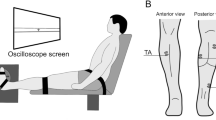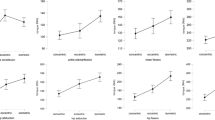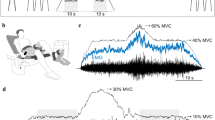Abstract
The purpose of this study was to determine motor output variability for different muscles in the same individuals. Ten young (21.7 ± 3.4 years) and ten elderly (72.1 ± 3.9 years) men underwent assessment of maximal isometric (MVC) and dynamic (1-RM) strength, and performed constant-force (2–50% MVC), constant-load (5–50% 1-RM load), and unloaded postural contractions as steadily as possible with the first dorsal interosseus (FDI), elbow flexors (EF), and knee extensors (KE). The coefficient of variation (CV) of force for isometric contractions and the standard deviation (SD) of acceleration for concentric, eccentric, and postural contractions were calculated. The 1-RM load, the CV of force for four of five isometric target forces, and the SD of acceleration during postural contractions were correlated between the EF and KE muscles. MVC force, 1-RM load, and SD of acceleration during postural contractions were not correlated between the FDI/EF or FDI/KE. The CV of force was correlated between the FDI/EF and FDI/KE for two of five isometric target forces. The SD of acceleration during concentric and eccentric contractions was not correlated between muscles. The normalized fluctuations during isometric contractions were greater for the FDI compared with the EF and KE. Elderly adults displayed greater fluctuations only for the FDI during low-force isometric and postural contractions. The dominant frequency of fluctuations was similar for the EF and KE muscles. The correlated fluctuations for the EF and KE muscles, within subjects, suggests that the two motor neuron pools transform the various neural inputs similarly.







Similar content being viewed by others
References
Baker MR, Baker SN (2002) The effect of diazepam on motor cortical oscillations and corticomuscular coherence studied in man. J Physiol 546.3:931–942
Bazzucchi I, Felici F, Macaluso A, De Vito G (2004) Differences between young and older women in maximal force, force fluctuations, and surface EMG during isometric knee extension and elbow flexion. Muscle Nerve 30:626–635
Brouwer B, Ashby P (1990) Corticospinal projections to upper and lower limb spinal motoneurons in man. Electroencephalogr Clin Neurophysiol 76:509–519
Brown WF, Strong MJ, Snow R (1988) Methods for estimating numbers of motor units in biceps-brachialis muscles and losses of motor units with aging. Muscle Nerve 11:423–432
Burnett RA, Laidlaw DH, Enoka RM (2000) Coactivation of the antagonist muscle does not covary with steadiness in old adults. J Appl Physiol 89:61–71
Christou EA, Carlton LG (2001) Old adults exhibit greater motor output variability than young adults only during rapid discrete isometric contractions. J Gerontol A Biol Sci Med Sci 56:B524–B532
Christou EA, Jakobi JM, Critchlow A, Fleshner M, Enoka RM (2004a) The 1- to 2-Hz oscillations in muscle force are exacerbated by stress, especially in older adults. J Appl Physiol 97:225–235
Christou EA, Rudroff T, Moritz C, Enoka RM (2004b) The variability in motor unit discharge is determined by low-frequency oscillations in discharge rate. Program No. 188.9, 2004 Abstract Viewer/Itinerary Planner. Society for Neuroscience, Washington, DC. Online
Cussons PD, Matthews PB, Muir RB (1980) Enhancement by agonist or antagonist muscle vibration of tremor at the elastically loaded human elbow. J Physiol 302:443–461
De Luca CJ, LeFever RS, McCue M, Xenakis AP (1982) Behaviour of human motor units in different muscles during linearly varying contractions. J Physiol 329:113–128
Dum RP, Strick PL (1996) The corticospinal system: a structural framework for the central control of movement. In: Rowell LB, Shepherd JT (eds) Handbook of physiology. Section 12. exercise: regulation and integration of multiple systems. Oxford University Press, New York, pp 217–254
Durbaba R, Taylor A, Manu CA, Buonajuti M (2005) Stretch reflex instability compared in three different human muscles. Exp Brain Res 163:295–305
Elble RJ (2003) Characteristics of physiologic tremor in young and elderly adults. Clin Neurophysiol 114:624–635
Enoka RM, Christou EA, Hunter SK, Kornatz KW, Semmler JG, Taylor AM, Tracy BL (2003) Mechanisms that contribute to differences in motor performance between young and old adults. J Electromyogr Kinesiol 13:1–12
Feinstein B, Lindegard B, Nyman E, Wohlfart G (1955) Morphologic studies of motor units in normal human muscles. Acta Anat 23:127–142
Fuglevand AJ, Winter DA, Patla AE (1993) Models of recruitment and rate coding organization in motor-unit pools. J Neurophysiol 70:2470–2488
Galea V, de Bruin H, Cavasin R, McComas AJ (1991) The numbers and relative sizes of motor units estimated by computer. Muscle Nerve 14:1123–1130
Galganski ME, Fuglevand AJ, Enoka RM (1993) Reduced control of motor output in a human hand muscle of elderly subjects during submaximal contractions. J Neurophysiol 69:2108–2115
Gordon KE, Ferris DP (2004) Proportional myoelectric control of a virtual object to investigate human efferent control. Exp Brain Res 159:478–486
Graves AE, Kornatz KW, Enoka RM (2000) Older adults use a unique strategy to lift inertial loads with the elbow flexor muscles. J Neurophysiol 83:2030–2039
Hagbarth KE, Young RR (1979) Participation of the stretch reflex in human physiological tremor. Brain 102:509–526
Hamilton AF, Jones KE, Wolpert DM (2004) The scaling of motor noise with muscle strength and motor unit number in humans. Exp Brain Res 157:417–430
Hortobagyi T, Tunnel D, Moody J, Beam S, DeVita P (2001) Low- or high-intensity strength training partially restores impaired quadriceps force accuracy and steadiness in aged adults. J Gerontol A Biol Sci Med Sci 56:B38–47
Jones KE, Hamilton AF, Wolpert DM (2002) Sources of signal-dependent noise during isometric force production. J Neurophysiol 88:1533–1544
Joyce GC, Rack PM (1974) The effects of load and force on tremor at the normal human elbow joint. J Physiol 240:375–396
Katz R, Mazzocchio R, Pâenicaud A, Rossi A (1993) Distribution of recurrent inhibition in the human upper limb. Acta Physiol Scand 149:183–198
Keen DA, Yue GH, Enoka RM (1994) Training-related enhancement in the control of motor output in elderly humans. J Appl Physiol 77:2648–2658
Koceja DM, Kamen G (1991) Interactions in human quadriceps-triceps surae motoneuron pathways. Exp Brain Res 86:433–439
Kornatz KW, Christou EA, Enoka RM (2005) Practice reduces motor unit discharge variability in a hand muscle and improves manual dexterity in old adults. J Appl Physiol 98:2072–2080
Kukulka CG, Clamann HP (1981) Comparison of the recruitment and discharge properties of motor units in human brachial biceps and adductor pollicis during isometric contractions. Brain Res 219:45–55
Laidlaw DH, Kornatz KW, Keen DA, Suzuki S, Enoka RM (1999) Strength training improves the steadiness of slow lengthening contractions performed by old adults. J Appl Physiol 87:1786–1795
Laidlaw DH, Bilodeau M, Enoka RM (2000) Steadiness is reduced and motor unit discharge is more variable in old adults. Muscle Nerve 23:600–612
Laidlaw DH, Hunter SK, Enoka RM (2002) Nonuniform activation of the agonist muscle does not covary with index finger acceleration in old adults. J Appl Physiol 93:1400–1410
Marsden CD, Rothwell JC, Day BL (1983) Long-latency automatic responses to muscle stretch in man: origin and function. Adv Neurol 39:509–539
Marsden JF, Ashby P, Limousin-Dowsey P, Rothwell JC, Brown P (2000a) Coherence between cerebellar thalamus, cortex and muscle in man: cerebellar thalamus interactions. Brain 123(Pt 7):1459–1470
Marsden JF, Werhahn KJ, Ashby P, Rothwell J, Noachtar S, Brown P (2000b) Organization of cortical activities related to movement in humans. J Neurosci 20:2307–2314
Moritz CT, Barry BK, Pascoe MA, Enoka RM (2005) Discharge rate variability influences the variation in force fluctuations across the working range of a hand muscle. J Neurophysiol 93:2449–2459
Palmer E, Ashby P (1992) Corticospinal projections to upper limb motoneurones in humans. J Physiol 448:397–412
Patten C, Kamen G (2000) Adaptations in motor unit discharge activity with force control training in young and older human adults. Eur J Appl Physiol 83:128–143
Penfield W, Boldrey E (1937) Somatic motor and sensory representations in the cerebral cortex of man as studied by electrical stimulation. Brain 60:389–443
Pollok B, Gross J, Dirks M, Timmermann L, Schnitzler A (2004) The cerebral oscillatory network of voluntary tremor. J Physiol 554:871–878
Rothwell JC (1998) Physiology and anatomy of possible oscillators in the central nervous system. Mov Disord 13 Suppl 3:24–28
Schiffman JM, Luchies CW (2001) The effects of motion on force control abilities. Clin Biomech (Bristol, Avon) 16:505–513
Seki K, Narusawa M (1996) Firing rate modulation of human motor units in different muscles during isometric contraction with various forces. Brain Res 719:1–7
Shinohara M, Moritz CT, Pascoe MA, Enoka RM (2005) Prolonged muscle vibration increases stretch reflex amplitude, motor unit discharge rate, and force fluctuations in a hand muscle. J Appl Physiol 99:1835–1842
Simon JR (1969) Effects of exposure to localized vibration on hand steadiness. Percept Mot Skills 28:91–94
Sosnoff JJ, Vaillancourt DE, Newell KM (2004) Aging and rhythmical force output: loss of adaptive control of multiple neural oscillators. J Neurophysiol 91:172–181
Sturman MM, Vaillancourt DE, Corcos DM (2005) Effects of aging on the regularity of physiological tremor. J Neurophysiol 93:3064–3074
Taylor AM, Christou EA, Enoka RM (2003) Multiple features of motor-unit activity influence force fluctuations during isometric contractions. J Neurophysiol 90:1350–1361
Topka H, Mescheriakov S, Boose A, Kuntz R, Hertrich I, Seydel L, Dichgans J, Rothwell J (1999) A cerebellar-like terminal and postural tremor induced in normal man by transcranial magnetic stimulation. Brain 122(Pt 8):1551–1562
Tracy BL, Enoka RM (2002) Older adults are less steady during submaximal isometric contractions with the knee extensor muscles. J Appl Physiol 92:1004–1012
Tracy BL, Howard RA (2004) Fluctuations in anke dorsiflexor force are similar in young and old men and women. Med Sci Sports Exerc Suppl 36:S123
Tracy B, Mehoudar P, Ortega J, Enoka R (2002) The steadiness of isometric contractions is similar between upper and lower extremity muscle groups. Med Sci Spts Exerc Suppl 34:S19
Tracy BL, Byrnes WC, Enoka RM (2004) Strength training reduces force fluctuations during anisometric contractions of the quadriceps femoris muscles in old adults. J Appl Physiol 96:1530–1540
Tracy BL, Maluf KS, Stephenson JL, Hunter SK, Enoka RM (2005) Variability of motor unit discharge and force fluctuations across a range of muscle forces in older adults. Muscle Nerve 32:533–540
Turton A, Lemon RN (1999) The contribution of fast corticospinal input to the voluntary activation of proximal muscles in normal subjects and in stroke patients. Exp Brain Res 129:559–572
Vaillancourt DE, Newell KM (2003) Aging and the time and frequency structure of force output variability. J Appl Physiol 94:903–912
Yoshitake Y, Shinohara M, Kouzaki M, Fukunaga T (2004) Fluctuations in plantar flexion force are reduced after prolonged tendon vibration. J Appl Physiol 97:2090–2097
Young RR, Hagbarth KE (1980) Physiological tremor enhanced by manoeuvres affecting the segmental stretch reflex. J Neurol Neurosurg Psychiatr 43:248–256
Acknowledgments
The authors thank Devin V. Dinenno and Seth J. Welsh for their significant contributions to the data reduction and analysis for this study.
Author information
Authors and Affiliations
Corresponding author
Rights and permissions
About this article
Cite this article
Tracy, B.L., Mehoudar, P.D. & Ortega, J.D. The amplitude of force variability is correlated in the knee extensor and elbow flexor muscles. Exp Brain Res 176, 448–464 (2007). https://doi.org/10.1007/s00221-006-0631-3
Received:
Accepted:
Published:
Issue Date:
DOI: https://doi.org/10.1007/s00221-006-0631-3




